Police officers talk with community activist Cynthia Davis in the Staten Island borough of New York, Tuesday, May 24, 2016. The recent highly publicized deaths of black men in encounters with police in Minnesota, Louisiana and across the country, and now the sniper killing of five Dallas officers, have focused new attention on the chasm between police and minorities, one of so many divides in this contentious election year. Years of tension have left people wary in both the policing community and in minority neighborhoods, with many yearning for one anotherâs respect. (AP Photo/Seth Wenig)
The Associated Press
NEW YORK (AP) - On an unusually cool night for summer, Mike Perry and his crew thread the sidewalks running through the Stapleton Houses, tracked by police cameras bolted to the apartment blocks and positioned atop poles.
Perry's group, five black men and one Latino, all acknowledge past crimes or prison time. Perry, himself, used to deal drugs around another low-income housing complex, two miles away. Now, though, their Cure Violence team works to defuse arguments that can lead to shootings. Their goals are not so different from those of the police.
While Perry gives cops their due, he keeps his distance. Two years ago, within walking distance of this spot, a black man named Eric Garner died in a confrontation with police officers. Garner was suspected of selling loose cigarettes; an officer wrestled him to the ground by his neck. His last words - "I can't breathe" - were captured on cellphone video that rocketed across the internet.
___
EDITOR'S NOTE - This story is part of Divided America, AP's ongoing exploration of the economic, social and political divisions in American society.
___
"I know those officers did not mean to kill Eric," says Perry, a 37-year-old father of two who knew Garner.
But, "you need to look an officer in the eye who doesn't understand and go, 'Brother, I want to get home, too.' They're defending these communities that they don't know."
As Americans struggle with the deaths of black men in encounters with police across the country, and now the killing of five Dallas officers, Perry and his fellow Staten Islanders have the dubious distinction of being a step ahead. Since Garner's death in July 2014, they have confronted a measure of the anger and pain the nation now shares.
A nationwide poll last summer by the Associated Press-NORC Center for Public Affairs found that 81 percent of black Americans said police are too quick to use deadly force, compared with 33 percent of whites. But the voices of Staten Islanders speak to attitudes and experiences that are often more complicated than poll numbers.
About 3,000 police officers live there, many in the heavily white neighborhoods on the southern two-thirds of the Island. In those neighborhoods, protests that followed Garner's death in July 2014 were met with "God Bless the NYPD" yard signs and pro-police rallies. The tensions intensified after a grand jury decided not to indict the officer for Garner's death. Two weeks later, a man claiming vengeance killed two officers in Brooklyn.
On an island of 475,000 that is 75 percent white and mostly suburban, the North Shore's comparatively dense neighborhoods are home to nearly all of the borough's African-Americans.
Leroy Downs, 41, has lived on Staten Island since he was 5 and works as a drug treatment counselor. But tonight he talks about, just maybe, becoming a cop, though as a black man he has been stopped repeatedly by police - without cause, he says.
Downs testified against the NYPD when a legal advocacy group sued and won a 2013 ruling that sweeping stop-and-frisks violate the constitutional rights of minority New Yorkers.
He sees little change in the relationship between cops and minorities despite the verdict. But he hasn't given up hoping.
"I can't imagine the world without police," he says. "It'd be anarchy."
The city says it has made some progress. Last year, it began assigning pairs of officers to specific neighborhoods, rather than having them rush from call to call across precincts. They are mandated to spend a third of their shift "off-radio," talking with residents to forge relationships.
Jessi D'Ambrosio, 32, and Mary Gillespie, 28, are the new "neighborhood coordinating officers" for the six-building Richmond Terrace project where Garner once lived. When the two officers, both white and longtime Staten Islanders, walk through the grounds, residents readily return their greetings.
"They're such homeboy, homegirl," tenants association president Eunice Love says of the two officers. "They know how to get along with people and relate and we love that."
D'Ambrosio measures progress in everyday experience. When one resident called to report a teen wanted for breaking into nearby houses, he took it as a sign of trust.
"It's small steps," he says. "You know you can't just wake up tomorrow and think the world is going to change. But they seem, still, to have accepted us."
Gwen Carr, Eric Garner's mother, wants more. She stands in the small park across the street from the spot where he fell and cringes as a man who appears to be homeless sprawls across a bench, asleep though it's not yet 1 p.m. And a young woman - "Alcohol Gives You Wings," tattooed down her left arm - sits on the edge of a dry fountain, trying to sell used shoes.
"How much good did they do?" Carr says of police. "Where are they when you need them?"
If her son's death means something, Carr says, officials can clean up this block where regulars say drinking and drugs have increased since Garner's death. She wants New York to turn the park into a playground, reserved for children and guardians.
Doug Brinson, who sells T-shirts from sidewalk tables, rails against police for Garner's death. But fighting and drinking on this block makes clear the need for police, he said.
"You've got to coexist with the guys on the beat. You've got to," he says. "It's only fair."
___
Adam Geller can be reached at features@ap.org. Follow him on Twitter at https://twitter.com/AdGeller
Members of the Cure Violence group talk with a man near the Stapleton Houses low-income housing complex in the Staten Island borough of New York, Wednesday, June 8, 2016. The group, five black men and one Latino, all acknowledge past crimes or prison time. Mike Perry, second right, used to deal drugs around another low-income housing complex, two miles away. Now, though, their team works to defuse arguments that can lead to shootings and match people with job training and counseling. (AP Photo/Seth Wenig)
The Associated Press
Mike Perry, left, and other members of the Cure Violence group, meet with a resident while patrolling the Stapleton Houses area in the Staten Island borough of New York, Wednesday, June 8, 2016. Their team works to defuse arguments that can lead to shootings and match people with job training and counseling. (AP Photo/Seth Wenig)
The Associated Press

Mike Perry, with the Cure Violence group, looks at his phone as he patrols the Stapleton Houses area in the Staten Island borough of New York, Wednesday, June 8, 2016. While Perry gives cops their due, he keeps his distance. Two years ago, a black man named Eric Garner died in a confrontation with police officers. âI know those officers did not mean to kill Eric,â says the 37-year-old father of two who knew Garner. But, âyou need to look an officer in the eye who doesnât understand and go, âBrother, I want to get home, too.â Theyâre defending these communities that they donât know.â (AP Photo/Seth Wenig)
The Associated Press

Ricahrd Commesso, head of the NYC Verrazano 10-13 Association, made up of retired police officers, speaks during a meeting in the Staten Island borough of New York, Wednesday, June 15, 2016. A retired detective, he says, "Things have changed drastically... If you make an arrest today, there's somebody there with a camera and, my own personal opinion, you're getting a lot of kids today, just out of school, never had a job before, becoming a cop." (AP Photo/Seth Wenig)
The Associated Press
Members of the NYC Verrazano 10-13 Association, made up of retired police officers, say the Pledge of Allegiance during a meeting in the Staten Island borough of New York, Wednesday, June 15, 2016. One of the members can trace policing lineage from his grandfather's days as a bobby in northern England to his own son's promotion to detective in Brooklyn. Another recalls days on patrol when cops carried no radios. (AP Photo/Seth Wenig)
The Associated Press
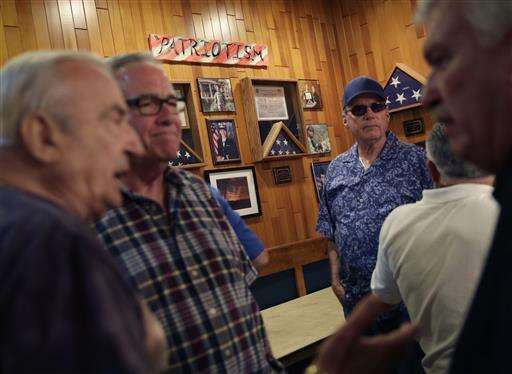
ADVANCE FOR USE THURSDAY, JULY 14, 2016 AND THEREAFTER-Members of the NYC Verrazano 10-13 Association, made up of retired police officers, gather during a meeting in the Staten Island borough of New York, Wednesday, June 15, 2016. Some of the members lament today's policing climate, even as they wax about the old days. Combine officers lacking street savvy and people in minority neighborhoods who mistrust them and policing is much tougher, says Richard Commesso, a retired detective. He credits his long-ago partner, a black cop, with schooling him to the ways of the neighborhoods they patrolled. (AP Photo/Seth Wenig)
The Associated Press
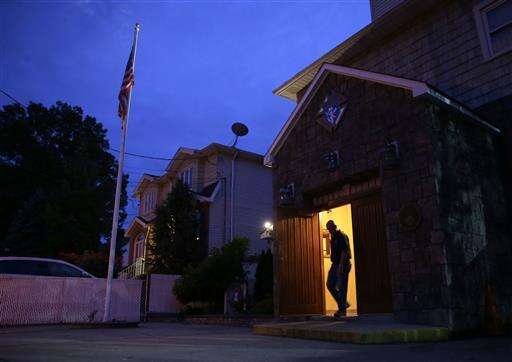
A U.S. flag flies outside a meeting of the NYC Verrezano 10-13 Association in the Staten Island borough of New York, Wednesday, June 15, 2016. Some of the members of the group of retired police officers lament today's policing climate, even as they wax about the old days. Combine officers lacking street savvy and people in minority neighborhoods who mistrust them and policing is much tougher, says Richard Commesso, a retired detective. He credits his long-ago partner, a black cop, with schooling him to the ways of the neighborhoods they patrolled. (AP Photo/Seth Wenig)
The Associated Press
Members of the Cure Violence group walk outside the Stapleton Houses complex in the Staten Island borough of New York, Wednesday, June 8, 2016. The Cure Violence team walks the streets to defuse arguments that can lead to shootings and match people with job training and counseling. (AP Photo/Seth Wenig)
The Associated Press
Leroy Downs plays basketball with local kids in the Staten Island borough of New York, Wednesday, May 25, 2016. Downs, 41, has lived on Staten Island since he was 5 and works as a drug treatment counselor. But he has thought about, just maybe, becoming a cop. Itâs not hard to imagine, given his almost paternal attention to the neighborhood. Except that Downs, has gone to court to fight the NYPD, and its widespread stop-and-frisks, mostly of black and Hispanic men. (AP Photo/Seth Wenig)
The Associated Press
Children dance during an event in front of the Richmond Terrace housing in the Staten Island borough of New York, Thursday, June 9, 2016. On an island of 475,000 that is 75 percent white and mostly suburban, the North Shoreâs comparatively dense neighborhoods are home to nearly all of the borough's African-Americans, enclaves of Liberian, Mexican, and Sri Lankan immigrants. (AP Photo/Seth Wenig)
The Associated Press
Lights illuminate a basketball court at the Stapleton Houses low-income housing complex in the Staten Island borough of New York, Wednesday, June 8, 2016. (AP Photo/Seth Wenig)
The Associated Press
This Tuesday, June 14, 2016 photo shows the VerrazanoâNarrows Bridge and the north side of the Staten Island borough of New York, foreground. Very few blacks live south of the Staten Island Expressway which continues from the bridge, and which some residents say amounts to a local Mason-Dixon line, reinforcing divisions of race and economics that shade the tensions around policing. (AP Photo/Seth Wenig)
The Associated Press
FILE - In this Thursday, Dec. 4, 2014 file photo, demonstrators protesting a grand jury's decision not to indict the police officer involved in the death of Eric Garner, carry mock coffins bearing the names of victims of fatal police encounters, during a rally on the Brooklyn Bridge in New York. A day earlier, a grand jury cleared a white police officer in the videotaped chokehold death of the unarmed black man, who had been stopped on suspicion of selling loose, untaxed cigarettes. (AP Photo/Jason DeCrow)
The Associated Press

FILE - In this Tuesday, July 14, 2015 file photo, The Rev. Al Sharpton, center, is seen on a television monitor, joined by Eric Garner's mother, Gwen Carr, left; daughter, Erica Garner, second from left; son, Eric Garner, third from left; daughter, Emerald Snipes, second from right, and wife, Esaw Snipes, during a news conference in New York. The family of Garner, a black man who died after being placed in a white police officer's chokehold, discussed the $5.9 million settlement it reached with the city days before the anniversary of his death. (AP Photo/Mary Altaffer)
The Associated Press
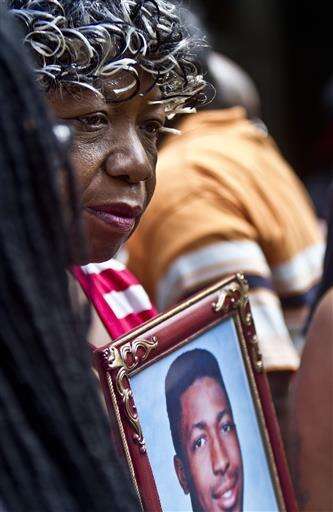
FILE - In this July 7, 2015, file photo, Gwen Carr holds a picture of her son, Eric Garner, during a news conference in New York with relatives of other New Yorkers killed by police. The city reached a settlement with the family of Garner, almost a year after the 43-year-old died in police custody. That does not satisfy his mother. If her son's death means something, officials can clean up the block where regulars, black and white, say drinking and drugs have increased since his death. Confrontational cops are not the answer, she says. (AP Photo/Bebeto Matthews, File)
The Associated Press
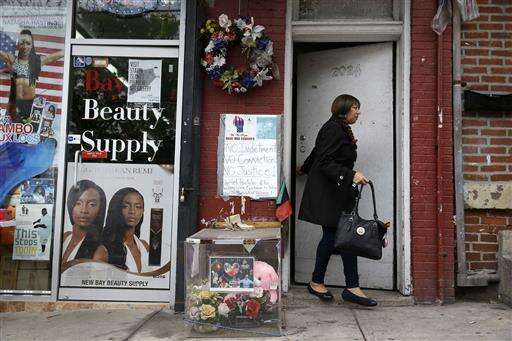
This Tuesday, May 24, 2016 photo shows a memorial at the site of Eric Garner's death in the Staten Island borough of New York. The 43-year-old black man died in July 2014 after a white police officer placed him in a chokehold during an arrest for selling loose cigarettes. A grand jury declined to indict the officer who put Garner in the hold or any of the other officers involved in the arrest. The city agreed to pay a $5.9 million civil settlement. (AP Photo/Seth Wenig)
The Associated Press

This Wednesday, May 25, 2016 photo shows a memorial to New York City police officers Wenjian Liu and Rafael Ramos in the Police Officer Rocco Laurie Intermediate School 72 in Staten Island, New York. On Dec 20, 2014, they were ambushed and shot to death in their marked police vehicle without warning. "A lot of kids in this school have parents who are police officers _ a lot," says Peter Macellari, principal of the school, where about a quarter of the students are Hispanic and 5 percent are black. He notes that Ramos was once the schoolâs security officer. (AP Photo/Seth Wenig)
The Associated Press
This Wednesday, June 8, 2016 photo shows a wall at the Cure Violence headquarters in Staten Island, New York. The Cure Violence team walks the streets to defuse arguments that can lead to shootings and match people with job training and counseling. (AP Photo/Seth Wenig)
The Associated Press
Police officers Mary Gillespie, right, and Jessi D'Ambrosio of the 120th precinct sit in their patrol van at the Richmond Terrace houses in the Staten Island borough of New York, Thursday, July 7, 2016. In 2015, the city began assigning pairs of officers to specific neighborhoods, rather than having them rush from call to call across precincts. They are mandated to spend a third of their shift "off-radio," talking with residents to forge relationships. The new approach was rolled out to the North Shore in December. (AP Photo/Mary Altaffer)
The Associated Press
Police officers Mary Gillespie, right, and Jessi D'Ambrosio of the 120th precinct, help Monique Williams, center, after she accidentally locked her two children inside the car with the air conditioner running, at the Richmond Terrace Houses in the Staten Island borough of New York on Thursday, July 7, 2016. (AP Photo/Mary Altaffer)
The Associated Press
Police officer Jessi D'Ambrosio, left, of the 120th precinct in the Staten Island borough of New York, speaks to a resident while on patrol at the Richmond Terrace Houses, Thursday, July 7, 2016. D'Ambrosio, 32, and his partner, Mary Gillespie, 28, are the new "neighborhood coordinating officers" for the six-building project where Eric Garner once lived. Jersey Street, with a reputation for crime, runs the length of a complex, most of whose residents are black. âWe want them to feel comfortable with us and thatâs what weâre building on,â Gillespie says. (AP Photo/Mary Altaffer)
The Associated Press
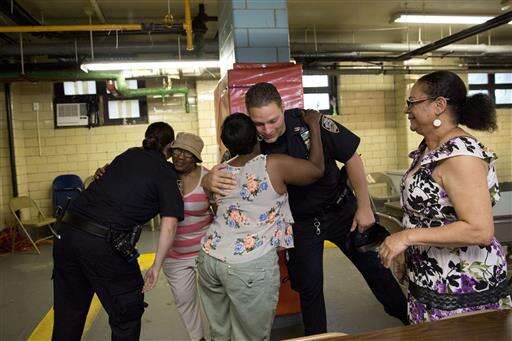
Police officer Mary Gillespie, left, of the 120th precinct on the Staten Island borough of New York, hugs Richmond Terrace Houses resident Gloria Phillips as fellow officer Jessi D'Ambrosio, center, hugs Barbara Shiel on Thursday, July 7, 2016. At right is Eunice Love president of the Richmond Terrace Houses. Love recalls years of seeing officers without knowing who they were. But D'Ambrosio and Gillespie? "They're such homeboy, homegirl," she says. "They know how to get along with people and relate and we love that." (AP Photo/Mary Altaffer)
The Associated Press
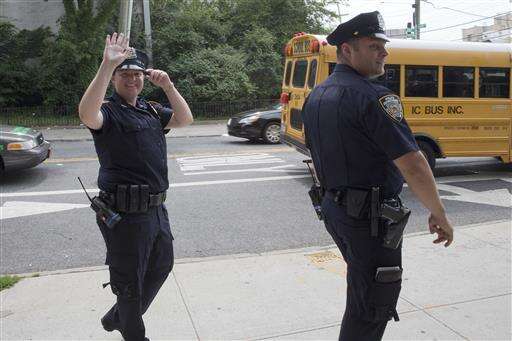
Police officer Mary Gillespie, left, of the 120th precinct on Staten Island borough of New York, waves at a residents of the Richmond Terrace Houses while on patrol with fellow officer Jessi D'Ambrosio on Thursday, July 7, 2016. In 2015, the city began assigning pairs of officers to specific neighborhoods, rather than having them rush from call to call across precincts. They are mandated to spend a third of their shift "off-radio," talking with residents to forge relationships. The new approach was rolled out to the North Shore in December. (AP Photo/Mary Altaffer)
The Associated Press